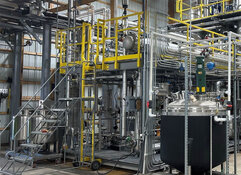Chen Lin: On my visit to China last summer, I experienced the air pollution problem firsthand. The No. 1 concern of the Chinese people is the huge blanket of smog covering major parts of China. How would you like to breathe smog every day? The good news is that because ethanol contains oxygen, it can significantly reduce smog from car emissions. In the U.S., it is very common to blend 10% ethanol into gasoline to reduce pollution.
In the U.S., ethanol is priced much cheaper than gasoline. In the futures market, gasoline is trading at $2.80, while ethanol is at $1.80. These prices change every day, but right now, that is a spread of $1. The truth of the matter is that it is much cheaper to run cars on ethanol than gasoline.
But there is a shortage of ethanol in China, and only a few places sell blended gasoline. There is great potential for China to massively import ethanol from the U.S. in order to reduce pollution and cheapen motorists' gasoline.
TER: Does China have the potential to produce its own ethanol?
CL: China is a food importer. China imports corn; it imports soy beans. Inside China, food costs are much higher than in the U.S. It is not at all economic to use corn in China to make ethanol.
TER: How can junior firms developing ethanol resources benefit from the increased use in ethanol in China and around the globe?
CL: Corn is the main cost for the junior ethanol producers. And the corn price is at a historical low, thanks to the huge harvest last year. We know that corn runs in multiyear cycles. Inventories build up. As a result of this large supply, ethanol producers' margins are at historical highs. If China's imports pick up, the ethanol price will go even higher. In conclusion, the margin for ethanol producers will be very high for at least a year or two. China is a big wild card. If China starts to import a large quantity of ethanol, we could see a multiyear bull market.
TER: Do you think the government would put any barriers on the import of ethanol, or would it encourage it?
CL: The main concern of the Chinese government and the Chinese people is pollution—not the gross domestic product. Smog sickness overrides almost anything. In November of last year, for the first time in many years, China started to import a significant amount of ethanol from the U.S. This could be the start of a trend of ever-increasing imports of U.S. ethanol.
TER: Are the engines of cars that are used on Chinese roads less efficient in terms of pollution than engines used in the U.S.?
CL: General Motors Co. (GM:NYSE) is one of the largest car producers in China, so the engines are quite similar to ours. We can fuel our engines with 10% ethanol. Brazil uses a 25% ethanol blend. China has basically no ethanol in its gasoline. The whole point of ethanol is to reduce pollution. I do not see any barriers ramping up the use of ethanol: I see a potentially dramatic increase in ethanol exports from the U.S. to China.
TER: If and when ethanol markets increase in China, how will that impact the refining industry for that product?
CL: Some gasoline refineries in the U.S. are also ethanol producers—such as Valero Energy Corp. (VLO:NYSE). Valero just reported huge earnings and a huge profit jump in its ethanol product line for Q4/13. Now may be the time for the larger ethanol producers to buy up the junior ethanol companies at low prices.
TER: Do you have any picks for us in the ethanol realm?
CL: I have been buying Pacific Ethanol Inc. (PEIX:NASDAQ). This company just came back from bankruptcy. It is trading at a very small fraction of what it was trading at a few years ago. It is based on the West Coast, which means that it benefits from West Coast ethanol prices being $0.40–0.60 higher than in the Midwest, thanks to the shortage of the railcars used to transport ethanol. Pacific Ethanol has a 160 million gallons ( 160Mgal)/year capacity right now. It may increase that capacity to 200 Mgal/year when it opens its fourth plant, which is likely to occur this year. Pacific Ethanol is the absolute cheapest ethanol company. And its stock is only $6–7 so it is trading 1x below its operating income.
Another company I own is Green Plains Renewable Energy Inc. (GPRE:NASDAQ). Similar to Valero, it has about a 1 Bgal/year ethanol production capacity. It is much bigger, which makes it an excellent takeover target for any refiner that wishes to get into the ethanol business.
TER: If Chinese demand increases, how will that affect these two companies?
CL: There is an abundance of ethanol in the U.S., and it's very effective in reducing car pollution. In decades past, we have seen that any commodity China really wants goes through the roof. We saw it in copper. We saw it in oil. We saw it in liquefied natural gas. If China starts mandating a 5% blend of ethanol to gasoline, then ethanol could easily trade on par with gasoline.
India imported a large quantity of ethanol in November. What if many countries start to follow Brazil and blend 25% ethanol into the gasoline? That's the future. If this trend is confirmed, ethanol will boom for years to come.
TER: Let's talk about fracking in North America, which you view as a profit-laden industry. Do you have any picks in that space?
CL: Fracking can help the U.S. reach energy independence in a few years. However, fracking is a very capital-intensive business. Investors looking at juniors need to be very careful about picking the right company because they can be beset with dilutions and issued shares. It is tough to own the company and suddenly find your shares diluted.
"Royal Dutch Shell Plc's partner, Terrace Energy, is a very attractive takeover target for Shell."
One of the fracking stocks that I particularly like is Terrace Energy (CVE:TZR). It just finished a capital raise, so it is cashed up. It controls a huge acreage at Eagle Ford. Its partner is Royal Dutch Shell Plc (RDS.A:NYSE; RDS.B:NYSE). 2014 is a very important for year for Terrace, as it is clearly an attractive takeover target for Shell. For one thing, Terrace is experimenting with different fracking methods to make these wells profitable, something Shell didn't do on its own. The initial data are very promising. If the trend continues, Terrace will be an easy takeover target for Shell.
TER: How is Terrace improving the fracking technology?
CL: The company is fracking one of the largest virgin lands in the Eagle Ford acreage with propane gas. So far, the results have been extremely encouraging.
TER: Does that mean that it pumps propane into the fracture instead of water and chemicals?
CL: Exactly. It pumps propane. It's a new technology.
TER: Let's not forget about more traditional oil and gas exploration and development ventures. I know that you cover a number of juniors, including Mart Resources Inc. (MMT:TSX.V), which has had some issues with its pipeline in Nigeria.
"2014 will be a very important year for Mart Resources Inc."
CL: Mart's existing pipeline can only ship less than half its capacity, and it loses 30% of that, which is far too high a loss ratio. 2014 will be a very important year for Mart. It is planning to build a new—reduced flow loss—pipeline that can more than double its exportable capacity. When that happens, there will be a huge jump for Mart's stock, a windfall cash flow, and potentially an increased dividend. It already pays a 17%/year dividend, so look for a double-digit dividend or even greater. We have been collecting the dividend now, while waiting for Mart to complete the new pipeline.
TER: Does Mart have partners?
CL: Yes, it has two Nigerian companies as its partners, which is good. You want local companies to be your face in Nigeria.
TER: Do you have any other oil and gas picks?
CL: When I examine my own successes and failures in stock picking during the past many years, it seems to me that making money in energy stocks is more and more difficult. A few years back, I was focusing on following cash flow when other energy investors were listening to the "big picture" talk from the management sector. That focus made me very successful, because I could find very solid stocks like Mart when it was $0.15. Now, everyone is starting to focus on cash flow. Investors learn quickly. But the point is that to make good money and hit home runs, investors need to look ahead of the crowds.
"To make good money, investors need to look ahead of the crowds. And that is why I have been buying Pan Orient Energy Corp."
And that is why I have been buying Pan Orient Energy Corp. (POE:TSX.V). The beauty of Pan Orient is that the stock is completely ignored by the market. 2014 will be the most important year in the company's history. Its operating field in Thailand is producing a little over 1 thousand barrels per day. Management left Canada to relocate to Thailand in order to reduce costs. The back story is that during the financial crisis of 2008-2009, Pan Orient accumulated a few important properties spread out in Canada, Thailand and Indonesia. This year is the year for exploring all three of these properties. The company has high-impact wells in each country. If any of the plays has success, the stock will go double digit, instead of trading at $1-something today. There has been a very strong insider purchase of the company in the past few months. Plus, its existing cash and cash flow more than justifies its current stock price. All this upside is being ignored by the market, which is a situation I really like.
TER: What is the political situation like for foreign companies that relocate to Thailand, like Pan Orient?
CL: The Pan Orient stock has weakened a little bit because of political unrest in Thailand. But Thailand is importing oil and even the protestors still need gasoline to drive their cars! During the bloody military coup that happened a few years ago, there was absolutely no interruption of the oil production in Thailand. Looking beyond the recent unrest in Thailand, I see a great buying opportunity. For one thing, Pan Orient's management is willing to do whatever it takes to get the job done. I applaud these managers for relocating to Thailand to focus on the production and exploration in-country. And when I talked to the CEO recently, he jokingly said the protests made commuting less crowded.
TER: In your portfolio, what kind of ratios do you use to allocate investments between ethanol stocks, oil and gas, and other energy stocks?
CL: I own a very large basket of oil and gas stocks, with a much heavier weighting than my ethanol picks. However, the ethanol story is just getting started. If there is a jump in ethanol exports to China and/or India during in the next months, or China starts to mandate 5% ethanol blended into gasoline, there will be an explosion of new opportunities for the ethanol juniors. Then I can confidently declare that the long-term bull market for ethanol is arriving. China has a bigger automobile market than the U.S. A 5% ethanol blend will take almost half the ethanol the U.S. produces. That will provide a tremendous gain for ethanol producers.
TER: Many thanks for your time, Chen.
CL: Until next time, Peter.
Chen Lin writes the popular stock newsletter What Is Chen Buying? What Is Chen Selling?, published and distributed by Taylor Hard Money Advisors Inc. While a doctoral candidate in aeronautical engineering at Princeton, Chen found his investment strategies were so profitable that he put his Ph.D. on the back burner. He employs a value-oriented approach and often demonstrates excellent market timing due to his exceptional technical analysis.
Read what other experts are saying about:
Want to read more Energy Report interviews like this? Sign up for our free e-newsletter, and you'll learn when new articles have been published. To see a list of recent interviews with industry analysts and commentators, visit our Interviews page.
DISCLOSURE:
1) Peter Byrne conducted this interview for The Energy Report and provides services to The Energy Report as an independent contractor. He or his family own shares of the following companies mentioned in this interview: None.
2) The following companies mentioned in the interview are sponsors of The Energy Report: Mart Resources Inc., Pan Orient Energy Corp. and Royal Dutch Shell Plc. Streetwise Reports does not accept stock in exchange for its services or as sponsorship payment.
3) Chen Lin: I or my family own shares of the following companies mentioned in this interview: Pacific Ethanol Inc. and call options, Green Plains Renewable Energy Inc. and call options, Mart Resources Inc., Pan Orient Energy Corp. and Terrace Energy. I personally am or my family is paid by the following companies mentioned in this interview: None. My company has a financial relationship with the following companies mentioned in this interview: None. I was not paid by Streetwise Reports for participating in this interview. Comments and opinions expressed are my own comments and opinions. I had the opportunity to review the interview for accuracy as of the date of the interview and am responsible for the content of the interview.
4) Interviews are edited for clarity. Streetwise Reports does not make editorial comments or change experts' statements without their consent.
5) The interview does not constitute investment advice. Each reader is encouraged to consult with his or her individual financial professional and any action a reader takes as a result of information presented here is his or her own responsibility. By opening this page, each reader accepts and agrees to Streetwise Reports' terms of use and full legal disclaimer.
6) From time to time, Streetwise Reports LLC and its directors, officers, employees or members of their families, as well as persons interviewed for articles and interviews on the site, may have a long or short position in securities mentioned and may make purchases and/or sales of those securities in the open market or otherwise.










































